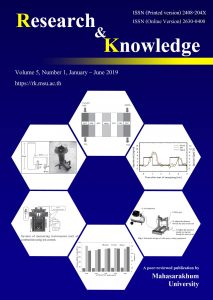Optimal control strategy for dengue transmission with second infection
Keywords:
Dengue fever, Mathematical model, Equilibrium, Optimal control theoryAbstract
This paper presents a mathematical model for dengue disease to understand its dynamics by using a set of differential equations to describe the effects between human and mosquito populations. In this model, the human population is divided into fi ve types of individuals: susceptible vaccination fi rst infectious second infectious and recovered and the mosquitoes population is divided into three types of individuals: larva mosquitoes uninfected female mosquitoes and infected female mosquitoes The epidemic and endemic analysis have also presented along with numerical simulations to verify our model. Our results suggested that the prevention and control of dengue outbreaks can be implemented in an optimal way.
References
Athithan, S. and Ghosh, M. (2015). Optimal control of tuberculosis with case detection and treatment. World Journal of Modelling and Simulation Mathematical Modelling, 11, 111-122.
Esteva, L. and Vargas, C. (1998). Analysis of a dengue disease transmission model. Mathematical Biosciences an international journal, 131-151
Thongtha, A. and Modnak, C. (2017). Optimal Control Strategy of a Dengue Epidemic Dynamics with Human-Mosquito Transmission. Burapha Science Journal., (Special Volume 2017), 333-342.
Van den Driessche, P. and Watmough, J. (2002). Reproduction numbers and sub-threshold endemic equilibria for compartmental models of disease transmission. Math Biosci, 180, 29–48.
Ali, T.M., Katim, F.A. and Kamil, A.A. (2015). Mathematical model of dengue fever and its sensitivity analysis. Pak. J. Statist., 31(6), 717-731.
Asano, E., Gross, L.J., Lenhart, S. and Rea, L.A. (2008), Optimal control of vaccine distribution in rabies meta population model, Mathematical Biosciences and Engineering, 219-238.
Bowman, C., Gumel, A.B., Van den Driessche, P., Wu, J. and Zhu, H. (2005). A mathematical model for assessing control strategies against West Nile virus. Bull. Math. Biol., 67(5), 1107-1133.
Singh, B., Jain, S., Khandelwal, R., Porwal, S. and Ujjainkar, G. (2014). Analysis of a dengue disease tramission model with vaccination. Advances in Applied Science Research., 5(3), 237-242
Rodrigues, H.S., Monteiro, M.T.T., Torres, D.F.M. and Zinober, A. (2012). Dengue disease, basic reproduction number and control. Int. J. Comput. Math., 89(3), 334-346.
Pontryagin, L.S., Boltyanski, V.G., GamkreliZe, R.V. and Mishchenk, E.F. (1967). The Mathematical Theory of Optimal Process, Wiley, New York.
World Health Organization (WHO), Dengue, July 2010. Available at http: www.who.int/topics/dengue/en.
Downloads
Published
How to Cite
Issue
Section
License

This work is licensed under a Creative Commons Attribution-NoDerivatives 4.0 International License.








